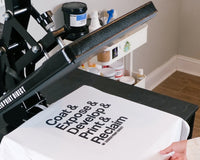So here’s a quick one to think about. Low temperature cure inks, ok big deal why would I need a low temperature ink, my inks work fine.
Ok, that may be true for what you are currently printing on which is most likely a run of the mill cotton shirt.
So, Mr. Know it all, what do you do when you are printing on poly or tri-blends? Or performance activewear? These types of materials are normally not the best when it comes to dye stability. In simplest terms, these types of materials are not good with high heat meaning that if you were to cure a tri-blend at your typical 330 degrees Fahrenheit it can cause issues such as dye migration, melting / burning the fibers in the fabric, and so on. Dye migration is when the pigment or dye from your shirt transfer into your inks. A common issue is trying to print a red tri-blend or poly shirt with white ink. When you do this with a standard white ink that is meant to cure at 330, it can cause the shirt’s red dye to “migrate” over into your white ink turning it pink and resulting in an upset customer yelling at you.
Tips to avoid this
- Print wet on wet onto a tri-blend fabric
- Try to avoid printing or using an underbase. Printing an under base requires you to flash that layer meaning heat, which is not tri-blends friend.
- Don’t be cheap! Buy the proper ink for the job.
- Cure at a lower temperature that will help avoid dye migration.
Good luck, and if you print a poly shirt with a normal white and you get dye migration don't say we didn't warn you!
Let's Talk
Remember, we are here to help! Drop a comment below or email our support team at info@screenprintdirect.com








3 comments
DARRYL HENRY
CAN YOU DO MULTICOLOR WITH THE FLOURESANT INKS. IVE NEVER DONE THIS BEFORE SO IM DEF A NEWBIE BUT BEEN READING AND LOVING YOUR COLORS. REALLY WANT TO TRY YOUR LOW CURE AND RAPID CURE BAD. AND WHAT IS THE SHIPPING TIME FRAME ROUGHLY. AND WILL MULTICOLOR WORK ON GRAY TSHIRTS GUIDANS. THANK YOU AND LOOKING FORWARD TO YOUR ANSWERS AND PURCHASING FROM YOUR COMPANY. AGAIN THANK YOU.
John C Shaeffer
Is this ok for multi color printing on cotton?
Do Tshirts, have stayed away from poly for reason you stated. But would be nice to have this if ok for both.
Thanks
Monster
Love the blogs! “Mr.know it all” hahahaha, excellent!! Keep up the good work!